Allen R Williams, Ph.D., Soil Health Academy Instructor
Parasite control in livestock is a major issue and has been heavily focused on for several decades now. There are numerous anthelmintics (chemical dewormers) available for internal parasite control and a host of pyrethroid and organophosphate products available for fly control. The issue with any of these products is that they are chemicals that impact not only the target pest but also other beneficial organisms. Parasite control products can negatively affect dung beetles, earthworms, other beetles, and a host of other beneficial insects.
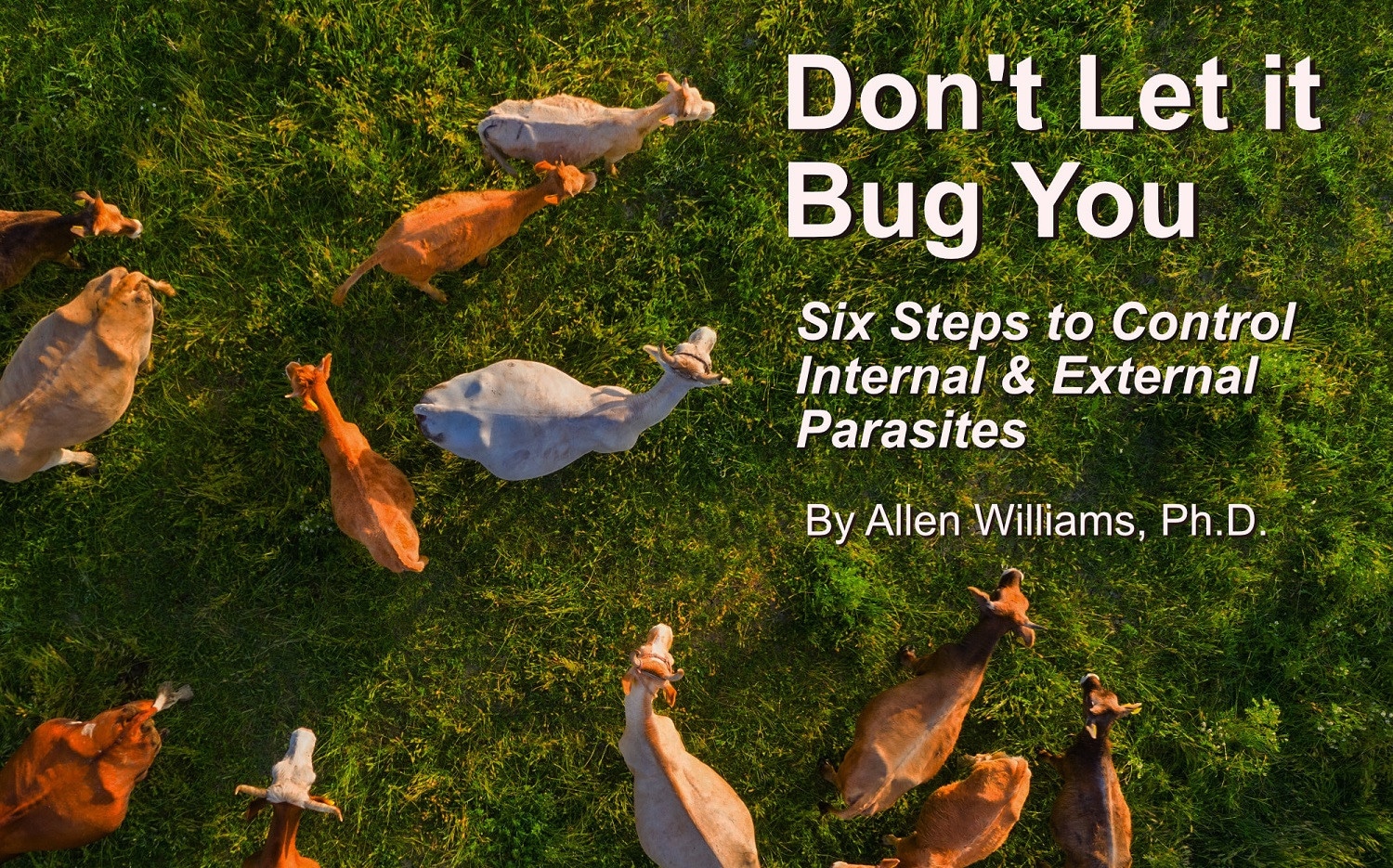
They are also costly. The treatments themselves cost several dollars per head and there is cost in administering the product. If the livestock have to be penned to apply treatment, then you must factor in the cost of labor and shrink (weight loss due to stress). In cattle, producers can spend anywhere from $25/head to almost $50/head annually for parasite control treatments (internal and external).
Is it possible to mitigate treatment and develop a herd that needs little to no internal and external parasite control intervention? The answer is Yes. The question is how we can accomplish this. I will outline a six-step program that will greatly reduce and even eliminate the need for treatment.
Step One: Genetic Resistance
All livestock species possess a certain level of natural resistance to internal and external parasites. There are individual animals within each species, breed, and herd/flock that display greater tolerance to parasites and those that display greater susceptibility. By identifying those individuals, we can start the process of culling susceptible animals and selecting for resistant animals.
The first step is to quit mass treatment, also known as metaphylactic treatment (treatment for prevention). By mass treating on a routine basis, it is quite hard to identify susceptible and resistant individuals. Stopping the treatment and using keen daily observation allows you to clearly identify those individuals showing much greater fly pressure and signs of internal parasites. In any herd you will notice some individuals that are routinely covered in flies while others are relatively free of flies. The same can be said for internal parasites. Some will exhibit little signs of infestation and others will seem to be routinely infested.
Moving livestock daily in an adaptive grazing program makes this selection process much easier. You are seeing the livestock on a more frequently as they pass right by you while entering the fresh paddock. Note the ones that appear to have issues and write down their ID. These would be animals to cull as soon feasible.
Since you will be stopping the mass treatment, I recommend treating the affected animals individually. This can also be accomplished while they move from one paddock to the next, using pour-ons and sprays.
With genetic selection for increased resistance, I would also recommend not keeping replacement breeding stock from cows that are marked for culling due to signs of susceptibility.
Step Two: Frequent Movement
One of the best ways to reduce internal and external parasite pressure is to keep livestock moving away from recent insect hatches. By utilizing adaptive grazing practices and moving the livestock daily, it becomes easier to keep livestock at a distance from these new hatches. During warm weather, fly eggs can hatch within 1-2 days, the larvae feed for 3-5 days and then pupate for 4-6 days before emerging as flies.
For internal parasites, infected livestock pass eggs through the manure onto the ground. During the warm season, eggs can hatch and then go through several larval stages until they become infective. This can take as little as six days. Livestock then swallow the infective larvae on moist grass during moderate temperatures. The infective larvae are usually transmitted when soil temperatures are between 550 F and 850 F and grasses are kept moist from frequent rainfall.
Re-infestation of internal parasites is usually our fault. If we are moving livestock daily, then there is very little opportunity for re-infestation to occur. It is actually easier to move away from internal parasite hatches than fly hatches, for obvious reasons (i.e., flies can fly). At times of heavy fly hatches, it may be necessary to move livestock a longer distance from recent hatches. That may mean altering your normal grazing rotation.
Rest periods between grazing events can play an important role in preventing re-infestation. It is recommended that pastures be allowed at least 40 days of rest before grazing again. Rest periods of 60 days or longer are even better.
Step Three: Dung Beetles and Other Beneficials
There are a host of beneficial insects that can control internal and external parasites. These include dung beetles, yellow dung flies (also known as golden dung flies), black dump flies, immature dragon flies, damsel-flies, fire ants, and parasitic wasps. Globally, there are more than 8000 dung beetle species with up to 90 species common in North America. Dung beetles can smell fresh manure and be on a newly deposited patty within seconds of it hitting the ground.
Since adult dung beetles have wings and can fly, they can easily follow the livestock as they move from paddock to paddock. A single adult dung beetle can bury up to 250 times it’s weight in dung on a daily basis. That’s a lot of manure incorporated into the soil in a short period of time.
The action of dung beetles and other beneficial insects can greatly reduce hatches of flies and internal parasites (Picture 1). The issue is that practically every chemical dewormer and fly control product impact not only the target pest organism but also a number of beneficials that are natural biological controls. If we are using chemical parasite control, we are damaging our dung beetle and beneficial populations. It should be noted that earthworm populations also take a hit when chemical dewormers are used.
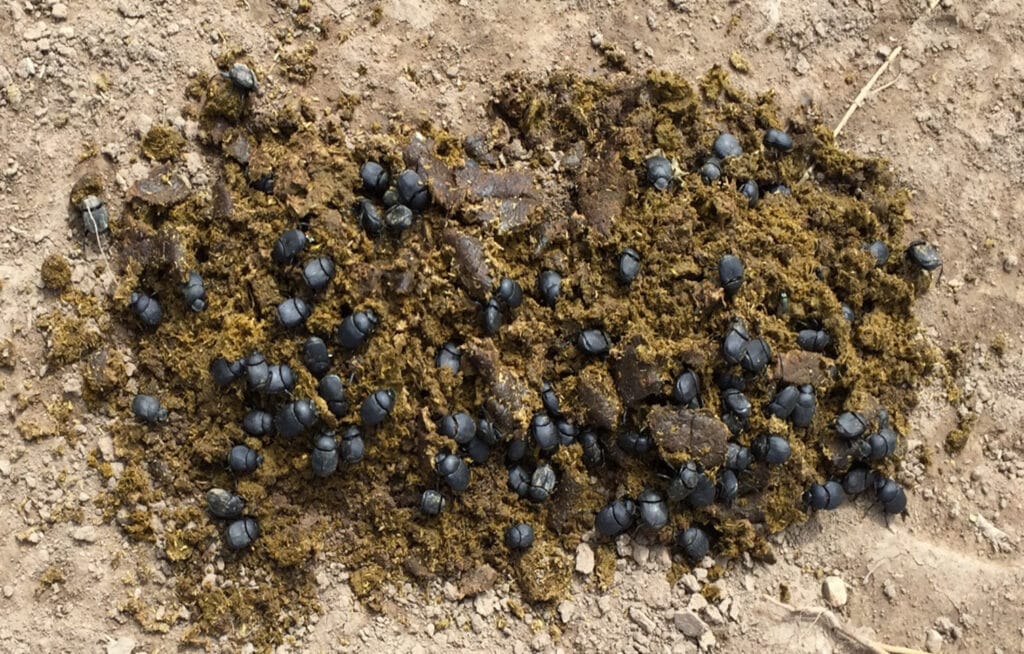
Step Four: Grazing High
For internal parasites, one of the best ways to prevent re-infestation is to “graze high.” Because stomach worm larvae are very susceptible to desiccation from sunlight and heat, they tend to stay within the first 3-4 inches of growth relative to the soil. By allowing livestock to graze too close we are facilitating ingestion of infective-stage larvae on a continuous basis. This is easily resolved by managing grazing events so that the livestock are not routinely grazing below 5-6 inches in forage height.
Most issues typically occur in the spring with the new flush of forage growth, the time when many grazers are quite anxious to get their livestock out and grazing, as soon as they notice the first tinge of green. This short, highly vegetative growth can be loaded with infective stage larvae and livestock can quickly incur a heavy parasite load.
Strategies to start early spring grazing can play a significant role in preventing this infestation. One strategy is to reserve a stockpiled pasture through the winter for use as the first pasture grazed in the spring. The mix of tall stockpiled grasses coupled with the new growth coming in underneath can be beneficial for preventing infestation.
Another strategy is to hold off on initial grazing until forages have achieved an average height of at least 8-10 inches. This is not only beneficial for preventing internal parasite infestation but also provides season-long benefits relative to forage biomass production. Grazing too early in the spring can negatively impact productivity for the rest of the year.
Step Five: Plant Species Diversity
This is one of the most overlooked strategies for control of internal and external parasites. Different plant species produce varying arrays of phytochemicals that not only are nutritive in value but also contain powerful anti-parasitic and medicinal properties. However, many pastures are monoculture or have low diversity so the ability of our livestock to routinely consume a diverse array of plant species is very limited.
Dr. Fred Provenza has conducted more than 30 years of research on the benefits of plant species diversity. Fred states conclusively that “Landscapes with diverse arrays of plants are nutrition centers and pharmacies with vast arrays of phytochemicals.” (Let Feed and Food Be Our Medicine. Understanding Ag Webinar. May 19, 2020). His works shows that animal health improves when livestock graze a diverse mix of plants compared to low diversity fields (Picture 2).
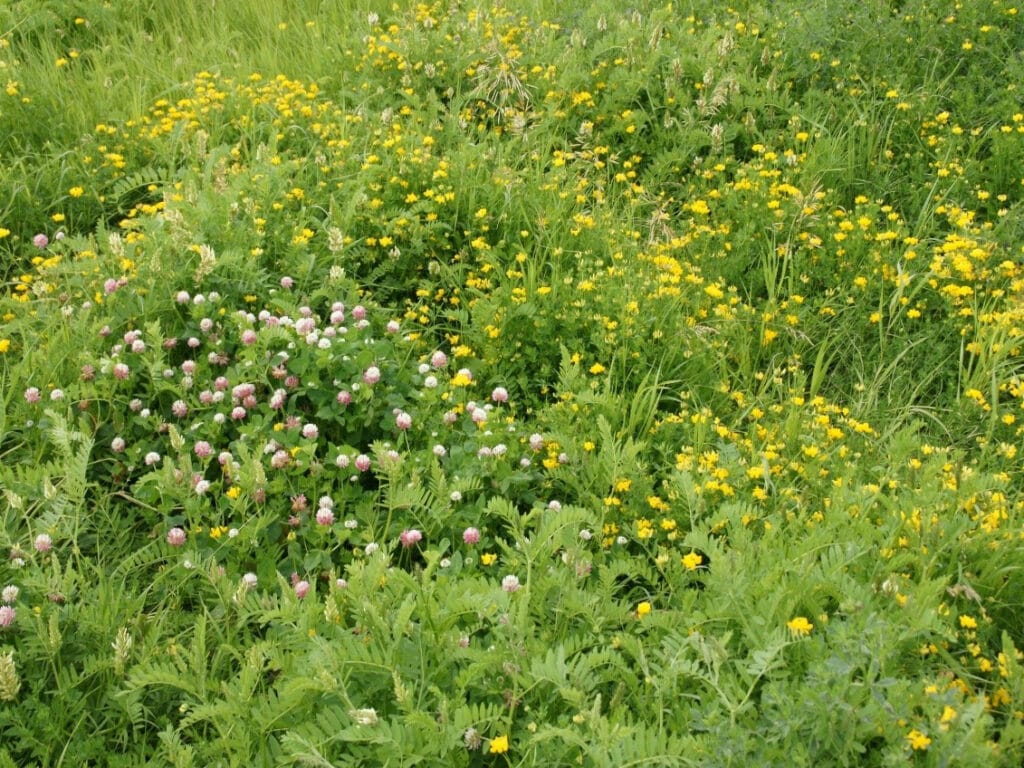
The plants that produce the highest quantity of these vital phytochemicals are often forbs. Many grazers view most forbs as weeds. However, these “weeds” are rich in compounds that contain tannins and other anti-parasitics. By eliminating forbs from our pastures, we are depriving our livestock of the opportunity to naturally deworm themselves.
Time after time, through astute observation, we have noticed our livestock purposefully selecting leaves from many different types of forbs. The individual animals that are doing this are the very ones that show far fewer signs and symptoms of internal and external parasite infestation. They are, in effect, taking preventative medicine through their plant selection.
Step Six: Multi-species Grazing
Many producers now have more than one species of livestock on their farms. Strategic use of multi-species grazing or foraging can have a profound impact on internal and external parasite control (Picture 3).
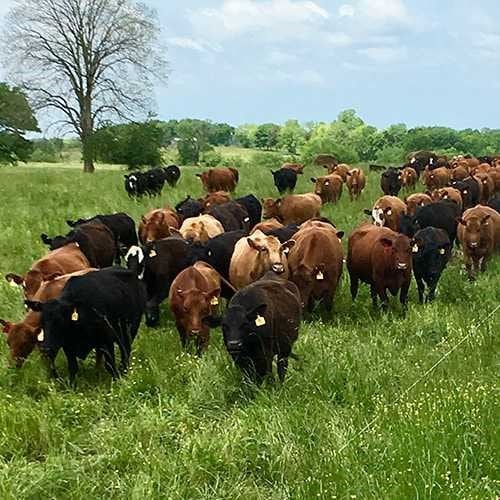
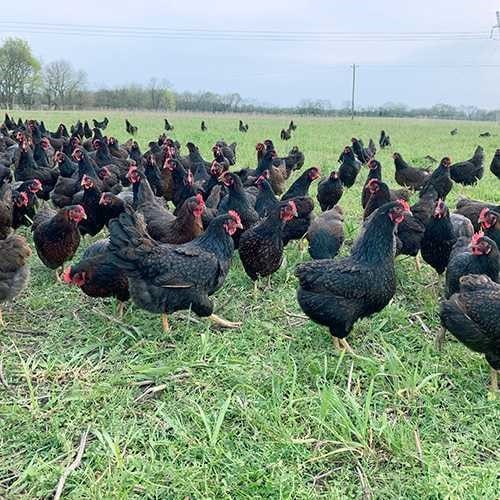
Picture 3. Multiple Species Can Disrupt Parasite Cycles.
Some species serve as dead-end hosts for parasites that affect other species. For example, cattle and horses serve as dead end hosts for sheep and goat parasites and vice versa.
Additionally, species such as chickens and pigs scratch through and root through manure patties in search of larvae to consume. As they consume larvae and spread out the manure through their efforts, the likelihood of larvae surviving to infective stage or fly larvae completing pupal stage is greatly diminished. These co-pastured species effectively serve as clean-up and sanitation specialists in the system.
If you have pastured chickens and pigs, you can move them through following cattle and sheep. I recommend moving the chickens through about 3-5 days after the ruminants and then follow with the pigs.
Summary
You now have six ways to effectively control livestock parasites without the expense and complications of using chemical controls. This is a great way to reduce input costs and to significantly improve your livestock performance and health. By combining all six in your management strategy you will be quite effective at mitigating parasite issues. In short order, your animals will be healthier and happier and you’ll be more profitable and happier, too.
